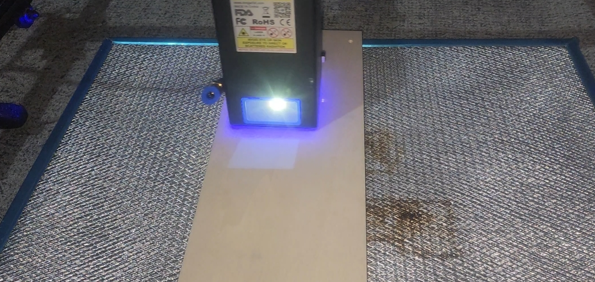10 Essential Safety Precautions for Home Laser Engraving Projects

Laser engravers, while they are incredible tools, they all come with their own set of risks if you do not handle them correctly. In this blog post, I will be going over 10 essential safety precautions you must follow to ensure that your laser engraving projects are not only successful but also completed safely.
Let's get started.
1. Understanding Your Laser Engraver
Each laser engraver has its own pros and cons. They also have their own safety risks depending on the type of laser. You have diode, fiber, and CO2 lasers which each come with their own sets of rules to follow.
It is your job to do the research on the laser of your choice before using it. Find out all you can about your laser before trying to complete any projects.
2. Proper Ventilation
Each material that you choose to engrave will all give off different types of fumes or dust. These fumes can irritate the lungs and may even contain carcinogens depending on the material being engraved. A proper ventilation system removes these fumes from the air, keeping the workspace safe for you.
3. Use of Protective Eyewear
Different materials react differently to the laser, producing varying fumes and hazards. Knowing this helps you choose proper ventilation and precautions (like using a fume extractor for certain materials).
4. Fire Safety
This is one of the main tips I can give you. When working with a laser engraver, many things can go wrong. I have personally witnessed engravings catching fire and had to put it out quickly. This usually happens when you're working with flammable materials like wood.
5. Material Knowledge
Now we move on to number 5. This section goes over simply letting you know that material selection or knowledge is very important. Knowing which material to choose for your projects is something that shouldn't be taken for granted.
You should take the time to study the material you will be using to find out if it flammable or to find out how flammable it is.
6. Workspace Organization
Your workspace should always be organized regardless of which work you are doing or which hobby you have. This is especially important when it comes to laser engraving or laser cutting. You want to have an organized workspace so that you are not bumping into anything while moving around. The laser beam that comes from a laser engraver is very dangerous and can cause permanent damage to our eyes if exposed. So, please, keep your workspace organized.
7. Machine Maintenance
Laser engravers are not cheap. Any laser engraver that you find that is cheap will usually cost you more in the long run or cost you extra right away. It is always best to invest in a good laser engraver as your first machine.
When you purchase a machine with your hard earned cash, you want it to work perfectly for as long as possible. On average, if a machine is well taken care of, it should last roughly 5 to 10 years. This all depends on the maintenance schedule and the amount of use the machine goes through.
8. Training and Expertise
When I started using laser engravers, I did not know anything at all. That was until I started researching everything from the software needed to the settings I need to set. Now I know most things needed to complete almost any laser engraving job.
I am however still learning new tips and tricks in this hobby and will continue to hone my skills.
9. Monitoring the Engraving Process
This is very necessary. I have never left any engraving process for too long without it being monitored. You should have someone monitor your laser engravings while they are in the process of being completed. You never want to leave your laser engraver running unattended. Many things can go wrong.
Some of these things include:
- Fire: Unattended engraving can ignite nearby flammable materials.
- Material damage: Incorrect settings or lack of monitoring can cause warping or melting.
- Runaway engraving: Software glitches could cause the laser to damage the material or itself.
- Machine damage: Debris buildup can harm the laser's components.
10. Emergency Preparedness
Having a fire extinguisher readily available in case of emergencies is very important. Knowing how to use it properly is also crucial and I never run my machine without one close by.
Additionally, understand what to do in case of accidental laser exposure (such as having eye wash stations available if necessary).
Conclusion
If you have any tips and tricks that you've learned while using your laser engraver, feel free to reach out and share them with me. I am all ears.
Related Articles
-
How to Laser Engrave Leather | Step-By-Step Guide
Can You Laser Engrave Leather?
How to Laser Engrave White Tiles Painted Black?
What Is The Best Low Cost Laser Engraver? My Opinion
How to Laser Engrave Acrylic with a Diode Laser: A Step-by-Step Guide
My Hands-On Review of the Monport 6-Watt Diode Laser Engraver
Laser Etching Glass
Laser Engraving A Photo | Full Guide
How Much Does Laser Engraving Cost
Is Laser Engraving Hard to Learn?
Why is laser engraving so expensive?
WHAT IS A LASER CUTTING MACHINE?
Top 7 Laser Engraving Business Ideas
10 Essential Safety Precautions for Home Laser Engraving Projects
Laser Engraving Cutting Boards | How To
Where To Buy Laser Cutting Materials?
Laser Engraving QR Codes
What Is DPI In Laser Engraving
How Much Is A Laser Engraving Machine